Sucre is a wonderful colonial citty and all the houses in its center are painted balzingly white - beautiful!
Sucre was once the capital of Bolivia and still is the "representative" capital besides La Paz. So you can find official buildings, such as the justice palace there,
and street parades are held frequently:
So Sucre is a picture perfect colonial city. Besides its architecture Sucre also offers a variety of colorful markets,
street and market musicians,
and lies in lush green valleys. Of course I had to hike up some of the hills around Sucre and check out the local sand stone blocks for climbing... Okay, no more climbing pictures for this post, I promise. just enjoy the view of white Sucre situated in green valleys:
I had a beautiful colonial hotel in the middle of town. Guess how much a single room in this hostal with private bath, T.V. etc. costs in Bolivia?
And? It is just 5€, no more! Besides the fact that Bolivia is really beautiful it is also incredibly cheap for travelling :)
I spent the first day walking around town, visiting museums, such as the Casa de Libertad,
and enjoyed the harmonic combination of white Sucre and its surrounding green nature. But one of the main reasons why I was in Sucre, was because I wanted to meet Anja there. Her sister Eliza spent a year volunteering in Sucre and so it was no coincidence that we could all meet up there. While I was waiting for Anja at the corner of my hostal, I saw the probably most perfect rainbow ever, don't you think so?
Beautiful isn't it? I had a couple of these rainbows the following days...
Finally, Anja showed up and we had lots of stories to tell each other while we strolled around in Sucre's center, went out for dinner and drinks.
The days in Sucre all passed by, such as this one and I had a wonderful and relaxing time there. Usually, my day started with the best breakfast I ever had in South America (for only 1,50€)
and then I met Anja and Eliza in the nearby Mercado Central (central market), where we had such fancy things as a Vitaminico (Beer, raw egg, various squeezed fruits, and herbs). That's what you look like before you drink this strange cocktail for the first time :)
Eliza obviously really the town well and showed us around in Sucre's colorful markets, such as the Mercado Campesino (farmer's market)
or the Mercado Negro (black market).
If you have already travelled with me, you know much I enjoy strolling through local markets and enjoy the taste, the smell, and the view of the local products, right kat and Franz?
Well, not always... but it is still interesting!
One of the products that I really start to enjoy here in Bolivia are the coca leaves:
By now I can even tell you the difference of coca coming from Cochacamba or the yungas. And yes, chewing coca leaves or using them for tea is legal here, thanks to Evo Morales. About 92% of all men and 81% of all women in Boliva chew coca leaves everyday. So as a tourist you cannot keep away from it and its bittersweet flavour...
Thanks to Anja and Eliza's company I had wonderful time in Sucre although there was physical activity or any stunning sights involved... just a good place to relax and hang out.
Eliza who stayed a year here was about to leave Sucre for good and of course lots of last minute things to organize. So Anja and I got a collectivo to Potosí and left Eliza behind.
Potosí
When we arrived in Potosí coming from green and warm Sucre, I couldn't trust my eyes - snow awaited us there:
Well no wonder, Potosí is situated at an elevation of above 4000m. But still, snow in the summer, so close to the equator? As it turned out the snow was just a remain of a really intense hail storm...
The reason for Potsí's existence, and also the reason for our visit is the mountain Cerro Rico dominating the city from every viewpoint. Cerro Rico once contained and incredible amount of silver and other minerals and was exploited by the Spanish conquistadores. There are uncountable many mines leading into Cerro Rico's interior. More than a million indigenuous people and African slaves died in the attempt to drive the mines deeper into the mountain and exploit more'n'more silver. That's why Potosí is also referred to as the "mouth of hell". On the contrary it has once been the largest and richest city of the world (!) and the Spanish's "captial of money"... Unfortunately, pretty much all the silver is exploited by now and the local miners have to work for a minimal salary while looking for other (partially toxic) minerals under medieval working conditions. So Potosí is still the "mouth of hell".
We spent our first evening in Potosí by strolling around town in the sunset,
admiring how the local people deal with the harsh climate,
visiting some of the more than 60 churches dominating the towns former richness,
and witnessing another parade and street party.
But the main reason why we were in Potosí was of course a visit to the mines of Cerro Rico and witness how the miners work under harsh and unhealthy conditions, just as 500 years ago. Of course, part of the money we paid for the tour to visit the workers in the mines was directed to them and their families. So they are happy to meet tourists underground and show them the mines. We were professionally equipped by former miners with protective clothing
and headlamps. So we looked like miners ourselves and were ready to enter the "mouth of hell."
But before we went to the local miners' market and bought some presents for them, such as dynamite, coca leaves (it is estimated that miners consume the equivalent of 450 kg gold per day in coca leaves), and liquor with 96% alcohol! Seriously, zoom into the lower picture and look at the bottle...
Our next stop before we entered the mines was a factory where the minerals are separated with the most ancient methods possible:
Finally, we entered the mines and worked our way crawling through narrow tunnels.
In a larger cave, the miners worshipped their god of the underworld. They are deeply catholic people, and so they believe in god in the sky and in the devil underground:
We worked our way down deeper into the mines climbing through narrow and slippery tunnels
and could seriously feel the lack of oxygen. The life expectancy of the miners is below 40 years due to all the toxic gases in the mines... We climbed down a ladder to the deepest section of the mine,
where we met some miners working with a hammer trying desperately to gain 30 cm a day!
Back overground we watched our guides set up some dynamite explosives:
Here mine and Anja's travels split again. While she's going to Uyuni together with Elisa, I am going North to La Paz, where I will meet up with my mother. I am really looking forward to La Paz since it is supposed to be one of the most impressive cities all over the world. Furthermore, I am of course looking forward to meet my mum there.
Hasta pronto in subterreno!
Flo




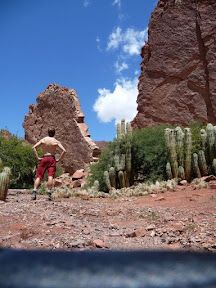



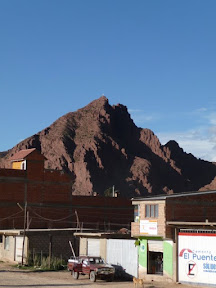








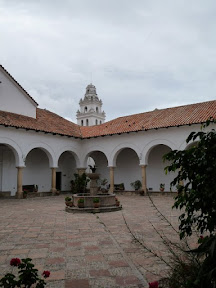
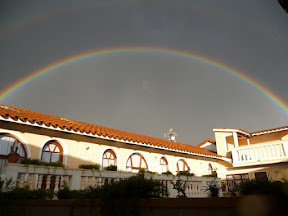

































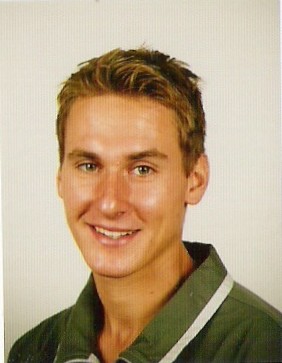
No comments:
Post a Comment